
Guests
- Aileen Mioko Smithexecutive director of Green Action, based in Kyoto, Japan.
- Saburo Kitajimacontract laborer and union organizer from the Fukushima Daiichi nuclear power plant.
- Gen ChijiiwaEnglish-Japanese translator.
We go to Japan to speak with Aileen Mioko Smith, executive director of the Kyoto-based group Green Action, as Japan marks the first anniversary of the massive earthquake and tsunami that left approximately 20,000 dead or missing and triggered a meltdown at the Fukushima Daiichi nuclear power plant. It was the world’s worst nuclear disaster since Chernobyl. About 326,000 Japanese residents remain homeless, including 80,000 evacuated from the vicinity of the Fukushima facility. Residents evacuated from the zone set up in a 12-mile radius around the nuclear plant are especially struggling to rebuild their lives. We also speak with Saburo Kitajima, a contract laborer and union organizer from the Fukushima Daiichi nuclear power plant. “The workers at the Fukushima plant are currently working under extreme circumstances,” Kitajima says. “In spite of being exposed to radiation, the levels of wages run to about $100 a day.” [includes rush transcript]
Transcript
AMY GOODMAN: We’re broadcasting on over a thousand stations, and one of those stations is in Japan, where we go right now, which is marking the first anniversary of the massive earthquake and tsunami that struck the country’s northeast coast. The twin disasters left approximately 20,000 dead or missing, as well as many more fearing the aftermath of radiation from the meltdown of three nuclear reactors at the Fukushima Daiichi nuclear power complex. The main memorial ceremony was held at Tokyo’s National Theatre, where Japan’s prime minister, Yoshihiko Noda, and Emperor Akihito remembered the victims of the national tragedy.
PRIME MINISTER YOSHIHIKO NODA: [translated] Our forebearers who built this country’s prosperity have emerged from each crisis even stronger. We will fulfill our historic mission of realizing the rebirth of this nation through reconstruction while holding hands with people in the disaster-affected regions and being close to them.
EMPEROR AKIHITO: [translated] I would like to take this opportunity to deeply thank the people who helped the victims and those in the disaster zones and those who helped deal with the nuclear crisis.
AMY GOODMAN: Across Japan and the world, there were hundreds of similar memorial services. The magnitude-9.0 offshore earthquake was the strongest recorded in Japan’s history and set off a tsunami that towered more than 65 feet high in some spots along the northeastern coast, destroying thousands of homes, wreaking widespread destruction.
Over the last year, Japan has struggled to recover. Nearly all the tsunami zone’s roads have been repaired, large swaths of land fully cleared of debris. However, some 325,000 people rendered homeless remain in temporary housing. While much of the debris has been gathered into massive piles, very little rebuilding has begun. For many residents, the traumatic events of last year remain fresh.
FUKUSHIMA RESIDENT: It’s been a year, but Fukushima is still affected by the nuclear plant and still hasn’t calmed down. So I can’t really let my children go outside. In that sense, I strongly feel that the crisis is really just now beginning.
AMY GOODMAN: Beyond the massive cleanup, many towns are still finalizing reconstruction plans, some of which involve moving residential areas to higher ground. Residents evacuated from the zone set up in a 12-mile radius around the Fukushima Daiichi nuclear plant are especially struggling to rebuild their lives. The government says the plant is stable and that radiation coming from the plant has subsided significantly. But the plant’s chief acknowledged to journalists visiting the complex recently it remains in a vulnerable state. In all, more than 1,600 people have been confirmed dead in Fukushima, 214 remain missing and are presumed dead. The government has acknowledged that some areas near the plant may be uninhabitable for decades.
For more, we’re joined by several guests. From Japan, we go to Aileen Mioko Smith, executive director of the Kyoto-based group Green Action. And here in the U.S., we’re joined in New York by Saburo Kitajima. He’s a contract laborer and union organizer from the Fukushima Daiichi nuclear power plant, accompanied by his English-Japanese translator, Gen Chijiiwa.
We welcome you all to Democracy Now! Aileen Mioko Smith, talk about what is happening now in Japan, what people are calling for, the memorial services today.
AILEEN MIOKO SMITH: Well, we had the memorial services, and, of course, everybody is in mourning, because one year ago we lost so many loved ones. And as you mentioned, the recovery is still ongoing, and many areas have not recovered at all. I just spoke with somebody who has evacuated from that area to our region, which is the Osaka-Kyoto area. And he went back home, and he overlooked—he went up on the high hills and looked down, and he said it’s still the same as it was a year ago. So there are various areas, but lots of rubble has still yet to be cleared.
In the Fukushima area—in Fukushima, there are two million people living in the prefecture, the state, and about three-quarters of those people are living under levels of very serious radioactive contamination. There are prefectures in—hot spots in surrounding areas that also have high levels. About 350,000 children are living under these conditions. And recently, the Japanese government said that it will go have an all-out effort to decontaminate Fukushima, the radiation, but that’s a long ways away. The decontamination has started, but how effective it can be—some areas have been decontaminated only levels—the radiation went down 10 percent, 20 percent. And some areas actually were measured higher afterwards. That’s because the hillsides bring down the radiation again.
But people are trapped there because of this alibi, this word “decontamination,” because people living 40, 50 miles outside, out from the reactors—this is in, for example, Fukushima City, which is the capital of the state, the prefecture, and another city, Date—these areas are 40, 50 miles away, and they are fighting to be evacuated. They call it “the right to evacuate,” and that’s because they want a compensation from the government if they elect to evacuate, and the government has refused. There hasn’t been a cent paid to people who want to self-evacuate, except a one-time payment of $1,043, and that’s it. And even the people who have officially evacuated have only received a first-time one-off payment of $13,043. This is—you know, you’ve had to leave your home. You’ve lost your home, as far as you know, forever maybe, and you’re living in limbo in evacuation, and you only receive that amount of money.
The other thing that’s been happening is that the prefecture, the state, of Fukushima initiated a health survey of the residents. This is a health survey about radiation. And only one out of five people have responded. I think there’s not—there’s not trust of government authorities. I mean, six months after the accident, you’re told, “Tell us what you ate the morning of the 12th. What size was your plate? Where were you that morning? And then at noon, where did you go?” Et cetera. And people are, I guess, fed up, and there’s been a really low response rate.
The other thing that we’re concerned is that—the Fukushima citizens’ organizations, there are lots of them. One is an organization to protect radiation—children from radiation. And they and us, Green Action, and several other groups, we asked the U.N. Office of the High Commission for Human Rights to investigate the violation of human rights of Fukushima children. This was back in the summer last year. And we know that the U.N., this office, asked the Japanese government—they wanted to come and investigate, they said, in November and December. But the government refused, or they said they were too busy, and then, later on, pretended that they were still waiting for the U.N. to contact them again, whereas in reality it was—the ball was in Japan’s government’s court, and the U.N. was waiting for them to respond. Anyway, the long and the short of it is Japan, unfortunately, successfully delayed the commission from coming in and investigating human rights violations in Japan until this November. So we’re very concerned. This is the year where Japan’s human rights record will be investigated, and we really want to address the violation of the children’s rights.
AMY GOODMAN: Aileen Mioko Smith, I want to thank you for being with us, joining us from Japan. Saburo Kitajima is with us here in New York, though usually in Japan. He worked at the Fukushima Daiichi plant, and he was a union organizer. Talk about the workers at the nuclear plant, where the meltdowns took place.
SABURO KITAJIMA: [translated] The workers at the Fukushima plant are currently working under extreme circumstances. To be more specific, the wages are extremely low, and there are no rights being observed at the moment. In spite of being exposed to radiation, the levels of wages run to about maybe $100 a day, more or less.
AMY GOODMAN: And exactly what were they exposed to, and what continues to happen at these plants? I mean, in the United States, we know very little about what’s happening in Japan.
SABURO KITAJIMA: [translated] In the course of our work, the type of work where people are exposed to the highest levels of radiation would be maintaining the water pipes that are being put in place to cool the reactor. And, of course, the entire site is extremely contaminated, and there is radiation that is coming from the ground.
AMY GOODMAN: What workers decided to go into—back into the plant afterwards, knowing how great the exposure would be?
SABURO KITAJIMA: [translated] We’re talking about workers who have always worked at perhaps the most marginalized jobs and who oftentimes are not aware of the risks and had no other choice but to go back.
AMY GOODMAN: You have been speaking at anti-nuclear protests in the United States. What is your message?
SABURO KITAJIMA: [translated] There’s two sides to it. And, of course, I would like the people who I met in New York to understand the situation in New York, to communicate what is exactly happening. At the same time, I would like that the people here support and stand with us in our struggles in Fukushima.
AMY GOODMAN: And what is your struggle in Fukushima? What are you calling for there?
SABURO KITAJIMA: [translated] For the moment, the workers at the Fukushima plant are demanding that they be compensated for exposure to radiation, which is not happening at the moment, and also kind of a compensation and being looked after, after working in these plants, since they must leave in a very short period of time.
AMY GOODMAN: And that short period of time is—what is the kind of levels of exposure they have right now?
SABURO KITAJIMA: [translated] Those exposed to the highest levels of radiation must leave the plant in a period of under two months.
AMY GOODMAN: Well, I want to thank you for being with us. And Saburo Kitajima is in the United States now but lives in Japan, has worked at the Fukushima Daiichi nuclear plant and is a union organizer there.
This is Democracy Now! We’re going to continue on lessons learned for U.S. nuclear power plants. Have we learned? We’ll be going to a nuclear whistleblower in Vermont. Stay with us.

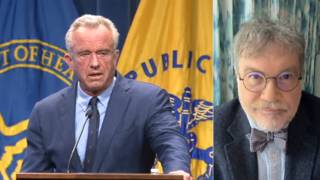

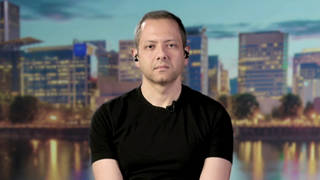
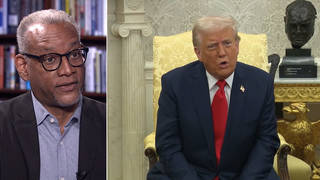
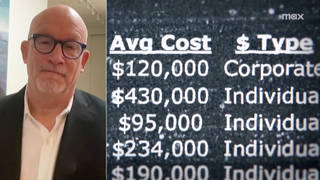
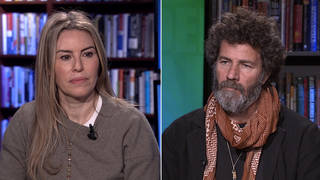
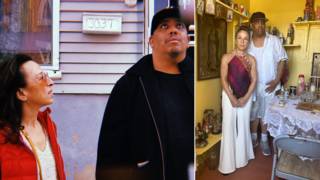

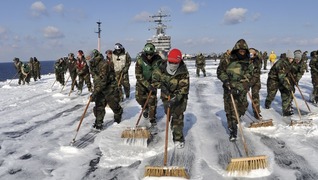

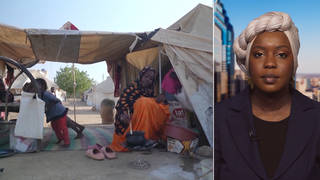
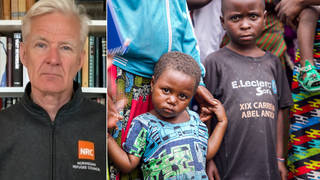
Media Options